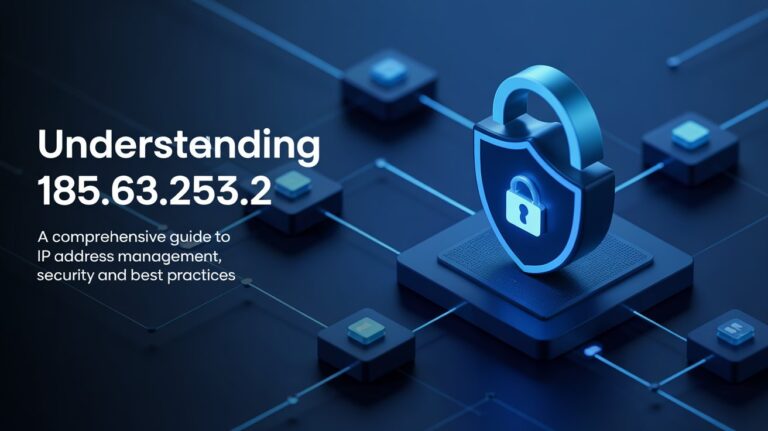Introduction
In today’s interconnected digital landscape, IP addresses like 185.63.253.2 serve as critical identifiers for devices and services on the internet. Whether you’re a network administrator, cybersecurity professional, or a curious user, understanding the nuances of IP addresses is essential for optimizing network performance, safeguarding data, and troubleshooting connectivity issues. This article delves into the specifics of 185.63.253.2, exploring its structure, security implications, and practical applications. We’ll also address common questions and challenges associated with managing similar IP addresses, ensuring you’re equipped with actionable insights.
1. What Is 185.63.253.2? Breaking Down the IP Address Structure
An IP address like 185.63.253.2 is a numerical label assigned to devices connected to a network using the Internet Protocol (IP). This address enables communication between devices by uniquely identifying them. The structure of IPv4 addresses, such as 185.63.253.2, consists of four octets separated by periods, each ranging from 0 to 255. The first three octets (185.63.253) often represent the network identifier, while the final octet (2) designates the host within that network.
Understanding this hierarchy is vital for subnetting, routing, and troubleshooting. For instance, 185.63.253.2 could belong to a specific server, IoT device, or router within a larger network. Geolocation tools might associate this IP with a region or organization, though accuracy varies. By analyzing its structure, administrators can infer network size, allocate resources efficiently, and identify potential conflicts.
2. The Role of 185.63.253.2 in Network Communication
Every IP address, including 185.63.253.2, acts as a gateway for data transmission. When a device sends a request—such as loading a webpage—the IP ensures the response reaches the correct destination. In enterprise settings, static IPs like 185.63.253.2 are often reserved for servers, printers, or critical infrastructure to maintain consistent connectivity.
Dynamic Host Configuration Protocol (DHCP) typically assigns temporary IPs, but static addresses require manual configuration. For example, a company hosting a website on 185.63.253.2 would ensure this IP remains unchanged to avoid service disruptions. Additionally, firewalls and routers use IPs to enforce security policies, such as blocking traffic from suspicious sources or prioritizing bandwidth for specific applications.
3. Security Implications of Using 185.63.253.2
IP addresses are frequent targets for cyberattacks. If 185.63.253.2 is exposed to the public internet, it could become vulnerable to port scanning, DDoS attacks, or unauthorized access attempts. Threat actors often exploit misconfigured devices or outdated software linked to static IPs. For instance, an unpatched server using 185.63.253.2 might be compromised to exfiltrate data or launch attacks on other systems.
To mitigate risks, organizations should implement robust security measures:
- Firewalls: Restrict inbound/outbound traffic to necessary ports.
- Intrusion Detection Systems (IDS): Monitor for anomalous activity targeting 185.63.253.2.
- Regular Updates: Patch vulnerabilities in devices associated with the IP.
- Access Controls: Limit administrative privileges to authorized personnel.
4. Troubleshooting Connectivity Issues with 185.63.253.2
Connectivity problems involving 185.63.253.2 can arise from hardware failures, misconfigurations, or network congestion. Begin by verifying physical connections—ensure cables, routers, and switches are functional. Next, use tools like ping or traceroute to test communication with 185.63.253.2. A timeout could indicate the device is offline, while packet loss might suggest network bottlenecks.
If the IP is part of a local network, check DHCP settings to confirm no conflicts exist. For public-facing IPs, consult ISP logs to rule out external outages. Advanced diagnostics might involve reviewing firewall rules or analyzing traffic with Wireshark to identify malformed packets disrupting communication.

5. Best Practices for Managing IP Addresses Like 185.63.253.2
Effective IP management ensures scalability and security. Consider these strategies:
- Documentation: Maintain an inventory of all static IPs, including 185.63.253.2, detailing their purpose and assigned devices.
- Subnetting: Segment networks to reduce broadcast domains and improve performance.
- IPv6 Transition: Plan for future scalability by adopting IPv6, which offers a larger address space.
- Regular Audits: Identify unused IPs and reallocate them to prevent waste.
Automation tools like IP Address Management (IPAM) software can streamline these tasks, reducing human error and enhancing visibility into network topology.
Conclusion
From its structural breakdown to its role in cybersecurity, 185.63.253.2 exemplifies the importance of meticulous IP address management. By adopting best practices and staying vigilant against threats, organizations can optimize network efficiency and safeguard critical assets. Whether you’re troubleshooting a connectivity hiccup or hardening defenses, a deep understanding of IP mechanics is indispensable in our digitally driven world.
Frequently Asked Questions (FAQs) About 185.63.253.2
Q1: How do I determine if 185.63.253.2 is a public or private IP?
A: 185.63.253.2 is a public IP, as it falls outside the reserved private ranges (e.g., 10.0.0.0/8, 192.168.0.0/16). Public IPs are routable over the internet, whereas private IPs are used internally within networks.
Q2: Can I block traffic from 185.63.253.2 if it’s malicious?
A: Yes. Use firewall rules or security groups to deny inbound/outbound connections to/from 185.63.253.2. Additionally, report the IP to threat intelligence platforms like AbuseIPDB.
Q3: Why can’t I ping 185.63.253.2?
A: The device may be offline, behind a firewall blocking ICMP requests, or configured to ignore pings. Use traceroute to identify where the connection drops.
Q4: Is 185.63.253.2 associated with any known services?
A: Without context, it’s difficult to confirm. Use reverse DNS lookup (nslookup 185.63.253.2) or consult WHOIS databases to identify the registered owner.
Q5: How do I assign 185.63.253.2 to a device on my network?
A: Access the device’s network settings, disable DHCP, and manually enter the IP, subnet mask, gateway, and DNS servers. Ensure the IP isn’t already in use to avoid conflicts.
By addressing these facets of 185.63.253.2, this guide empowers readers to navigate the complexities of IP management with confidence.
